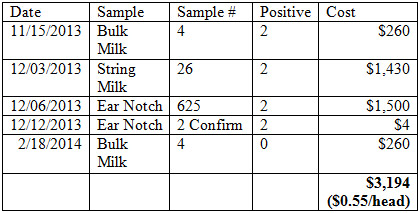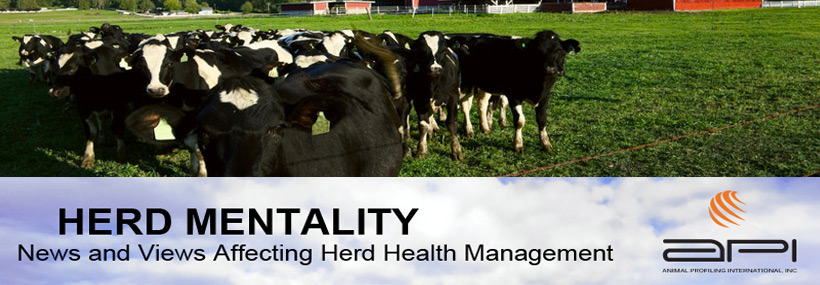BioSecurity – The Value to Your Dairy Operation
By Tom Shelton, M.S., D.V.M., Merck Animal Health, and Michael Coe, D.V.M., Ph.D., Animal Profiling International, for Progressive Dairyman
Screening, Removing BVD-PI Cows Pays Big
Implementing biosecurity measures on a dairy requires time and money, but the cost of diseases, in terms of treatment, lost production and animal well-being, also impose significant costs. There is certainly a price to pay when a new disease enters a herd, but that also holds true with a subclinical infection. Bovine Viral Diarrhea (BVD) can challenge a herd on both levels.
In the first article of this series, we compared National Animal Health Monitoring System (NAHMS) bulk milk data from 2007 to a more recent survey conducted by Merck Animal Health and Animal Profiling International, a testing laboratory in Portland, Ore. Of 182 dairies tested, 18 percent were BVD-positive. What’s more, of the 118 large dairies (greater than 500 cows), 28 percent were BVD-positive with the majority occurring in the West (24 percent versus 8 percent for the Midwest and East). This exceeded the 2007 NAHMS data for large dairies of which 12.8 percent were positive.
In this article, we’ll evaluate the actual costs associated with removing BVD persistently infected (PI) animals from herds that have been identified as BVD-positive from pooled bulk milk tank sampling. We’ll also look at the economics where subclinical disease has been maintained in herds versus eliminating BVD.
Ongoing Losses Add Up
It’s estimated that BVD-PI cows cause losses in the range of $20 to $88 per head, depending on the virulence of the strain present.¹ The BVD virus can affect the reproductive, respiratory and digestive systems, with greatest loss impacting reproduction.
Because PI cows are a constant source of virus shedding, infection spreads to other cows resulting in increased days open and decreased milk production. Early embryonic death is a common result of viremia in the first 45 days of pregnancy.
For example, on a large California dairy, cows previously confirmed pregnant but found to be open at 92 days declined from 14.3 percent to 7.8 percent following the identification and removal of BVD-PI cows that were causing early lactation abortions.²
Cost vs. Benefit
The following table shows the estimated preventable losses from BVD-PI cows compared to actual costs associated with removal.

The investment to monitor a dairy using bulk tank samples is minimal because one sample can represent 3,500 cows, with three samples submitted annually.
The timeline and investment presented in the table below provides an example of a large Idaho 6,000-cow dairy that completed the initial process to identify and remove BVD-PI cows from the herd.

PCR Test Identifies Culprits
In this next example, six dairies ranging from 1,800 to 6,000 head, had BVD prevalence rates in the lactating herds of 0.02 percent to 0.11 percent. The sensitivity of a real-time polymerase chain reaction (RT PCR) test applied to bulk tank milk samples enabled the dairies to work with their veterinarians to quickly and economically identify the one or two BVD-PI cows present in the lactating herd. The per-head cost to identify the PI cows in the lactating herd ranged from $0.23 for the ideal cleanup to $1.68 for a dairy that included three bulk tank screening tests (two positive) over a year.
The largest dairy identified only two BVD-PI cows in the lactating herd, both of which were open and remained in the breeding pen, exposing all early-pregnant cows. This dairy develops its own heifers and initiated a program to test all bred heifers prior to freshening, as well as all newborn heifers at birth.
Six months into the program, the dairy has tested 5,152 animals and identified 10 more BVD-PI heifers. The dams of the BVD-PI-positive heifers also are tested routinely to confirm their PI status. This can identify any BVD-PI cows coming back into the lactating herd that were not included in the bulk tank screening. However, finding a BVD-PI cow by tracing back from positive calves is extremely rare. Although the existing BVD-PI cows in a herd are responsible for continued exposure, most BVD-PI calves come from normal cows that have been inopportunely exposed.
Tips For Monitoring Success
Utilizing a bulk tank monitoring program for the lactating herd will provide an ongoing insurance policy to protect your “cleanup” investment, but the key to preventing reintroduction of BVD-PI animals is to introduce only BVD PI-negative tested animals.
Successful BVD-PI clean-up programs that utilize bulk tank milk and string samples to reduce the number of individual cows tested need to include:
1. Intact string data. Excellent record-keeping is required to identify all individuals making up the string samples. This includes minimizing animal movements after collecting the sample, as well as samples from cows leaving the string/herd.
2. Carryover milk contamination. Because the PCR test is extremely sensitive, carryover milk from a BVD-PI-positive string can cause the subsequent sample to incorrectly test positive, resulting in unnecessary individual testing.
3. Post-cleanup waiting period. Follow-up bulk tank samples should be collected no sooner than two weeks after BVD-PI-positive cows are removed from the lactating herd. This allows time for latent infections in exposed herd mates to decline.
BVD Silently Drains Profits
BVD has a big economic impact on many areas of a dairy. Yet, it is often a hidden threat because individually, these effects are often too small to be noticed. Collectively, they add up to a significant cost to the dairy.
As this article illustrates, only one or two BVD-PI cows can cost thousands of dollars. Estimates range from $20 per head to $88 per head, depending on the virulence of the strain. In contrast, the average per-head cost to identify BVD- PI cows ranged from $0.23 for the ideal cleanup of the lactating herd to $1.68 for a dairy requiring more extensive testing. The bottom line? For less than $2 per head, dairy producers can have peace of mind and a healthier herd.
Testing is only one component of a complete BVD control program. Proper vaccination, biosecurity and bio-containment all play a role in a comprehensive BVD plan. The long-term goal is always to create the best opportunity to increase, or at least maintain, overall herd efficiencies.
For the final article in this series, we will review testing do’s and don’ts for removing BVD-PI cows, as well as the human and laboratory pitfalls. In addition, we will address Bovine Leukemia virus and Johne’s disease, which negatively affect herd health, production and annual profits, but can be managed within a well-designed bulk milk disease monitoring program.
References:
1. Impact of BVD on Dairy Herd Profitability, John Vanleewun, Center for Epidemiological Research, Atlantic Veterinary College, UPEI, Canada.
2. Data on file at API, Inc.

